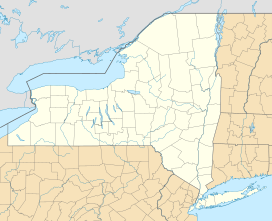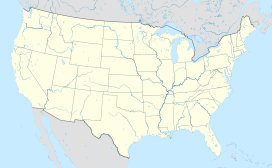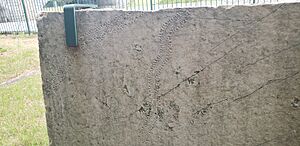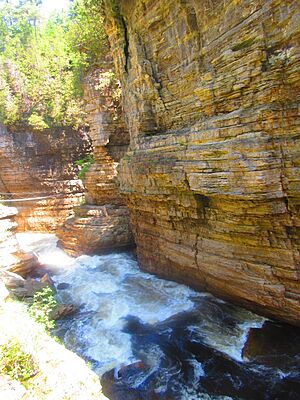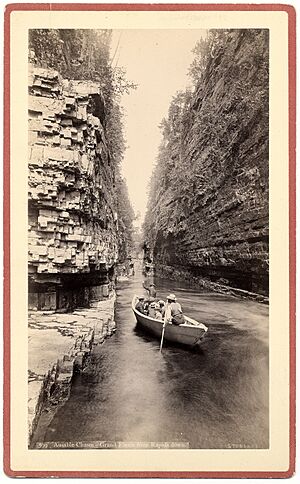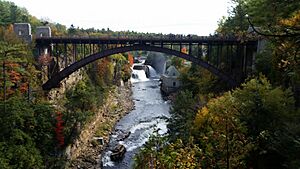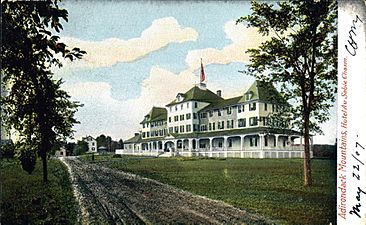Ausable Chasm facts for kids
Quick facts for kids Ausable Chasm |
|
|---|---|
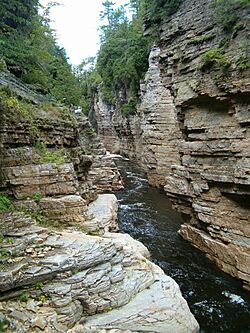
Ausable Chasm
|
|
| Length | 2 miles (3.2 km) |
| Depth | 150 miles (240 km) |
| Geology | |
| Age | 10,000 years old |
| Geography | |
| Location | Keeseville, New York |
| Country | United States |
| Rivers | Ausable River |
Ausable Chasm is a stunning canyon carved from sandstone rock. It is a popular place for visitors near Keeseville, New York, in the United States. This amazing gorge stretches about 2 miles (3.2 km) long and is around 150 feet (46 meters) deep.
The Ausable Chasm gets its name from the Ausable River, which flows through it. The river then empties into Lake Champlain about 1 mile (1.6 km) away. This deep canyon began to form about 10,000 years ago. It was created by a process called "headward erosion," where a waterfall slowly carves its way backward. This waterfall, called Rainbow Falls, is 91 feet (28 meters) tall and is at the southern end of the gorge. Ausable Chasm is a famous landmark and a big attraction in the Adirondacks region of Upstate New York.
Contents
How Ausable Chasm Formed
Ausable Chasm is carved into very old rock called Potsdam Sandstone. This rock is about 500 million years old and forms a layer about 520 feet (158 meters) thick. The sandstone formed from ancient tidal flats, which were shallow areas where the sea met the land. You can still see ripple marks from old waves, ichnofossils (trace fossils like footprints or trails), and even rare jellyfish fossils from the mid-Cambrian period in the rock.
The chasm itself was created at the end of the last Ice Age, about 10,000 years ago. Before the gorge formed, huge sheets of ice, called the Laurentide ice sheet, moved across the land. They carved out deep cliffs in the Champlain Valley. When the ice melted, it formed a huge body of water called the Champlain Sea, which covered the area where the chasm is now.
The real carving of Ausable Chasm began when the land slowly rose after the heavy ice sheets were gone. This caused the Champlain Sea to shrink. The Ausable River then flowed with much more water than it does today because of all the melting ice. This powerful river started to cut down through the loose soil and rocks left by the glaciers. Once the river reached the hard Potsdam Sandstone, it plunged over a hidden cliff, creating the first Rainbow Falls.
As the waterfall slowly moved backward, it carved the canyon deeper. The river used natural cracks in the sandstone, which made the canyon's path sharp and angular. While the horizontal layers of sandstone are very strong, these vertical cracks allowed the river to cut through. Over 10,000 years, the Ausable River sometimes changed its path. It left behind old riverbeds, called paleochannels. Two of these, the Big Dry Chasm and Little Dry Chasm, can be explored by visitors today, along with the main gorge.
Today, Ausable Chasm is a type of canyon called a "box canyon." Rainbow Falls has carved this 2-mile (3.2 km) long gorge from its original spot to where the visitor's center is now. The building of a dam upstream and the redirection of water from Rainbow Falls have mostly stopped the gorge from changing much more. Some interesting rock formations in the chasm have special names, like Jacob's Well (a large pothole), the Cathedral, the Devil's Oven (a cave), Elephant's Head, the Flume, Sentinel Rock, and Table Rock.
A Look Back in Time
Evidence shows that Native American people lived near Ausable Chasm a long time ago. In the 1600s, the land around the chasm was a disputed area between the Mohawk people and Algonquian tribes. Native Americans left the area around 1810.
In 1760, a man named Major John Howe explored the chasm using ropes. Five years later, in 1765, an early Irish settler named William Gilliland discovered the chasm while exploring the shore of Lake Champlain. Gilliland wrote in his journal that the gorge was "a most admirable sight," looking like "a regular built wall." He thought the huge crack might have been caused by an earthquake.
Even though Gilliland's settlement was destroyed during the American Revolutionary War, the growth of the logging industry led to more people settling near the gorge. This created the village of Keeseville. The first bridge across the chasm, made of two logs with boards, was built in 1793. Later, in the late 1800s, Rainbow Falls was used to power a factory that made horse nails. This factory closed in 1925. That same year, the AuSable Chasm Bridge was opened, carrying US 9 over the Ausable River at the southern end of the chasm.
Visiting Ausable Chasm Today
People started visiting the chasm for fun in 1873. A group of businessmen formed the Ausable Company and offered tours by boat for 25 cents. They also built wooden walkways. Over the years, famous people like Thomas Edison, John D. Rockefeller, Harvey Firestone, and Franklin and Eleanor Roosevelt visited. In 1897, President William McKinley even rode the rapids on the Ausable River. Silent movies were also filmed there, sometimes using the chasm for exciting stunts. A large hotel, the Hotel AuSable Chasm, was built in 1890 to welcome visitors, but it burned down in 1950.
In 1996, the chasm was hit by two big floods. The first flood in January was caused by a lot of snow melting quickly in the Adirondack Mountains. The visitor areas were badly damaged but were rebuilt even stronger. However, in November, another flood, caused by heavy rainfall, destroyed the new structures. After this second flood, most of the walking trails in the chasm were moved to higher ground to keep them safe.
Today, the chasm is known as the "Grand Canyon of the Adirondacks." It is a popular tourist spot where you can pay a fee to explore. There are five miles of trails that go around and inside the chasm. You can also enjoy activities like rock climbing, whitewater rafting, and a via ferrata (a climbing path with fixed cables and ladders).
Other Things to See
- North Star Underground Railroad Museum, This museum tells the story of the Underground Railroad and is run by the North Country Underground Railroad Historical Association. It is located on Mace Chasm Road in Ausable Chasm, New York.
Images for kids
- Pictures from 1907 postcards


